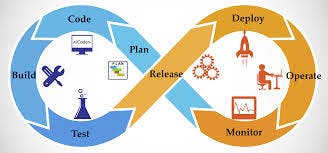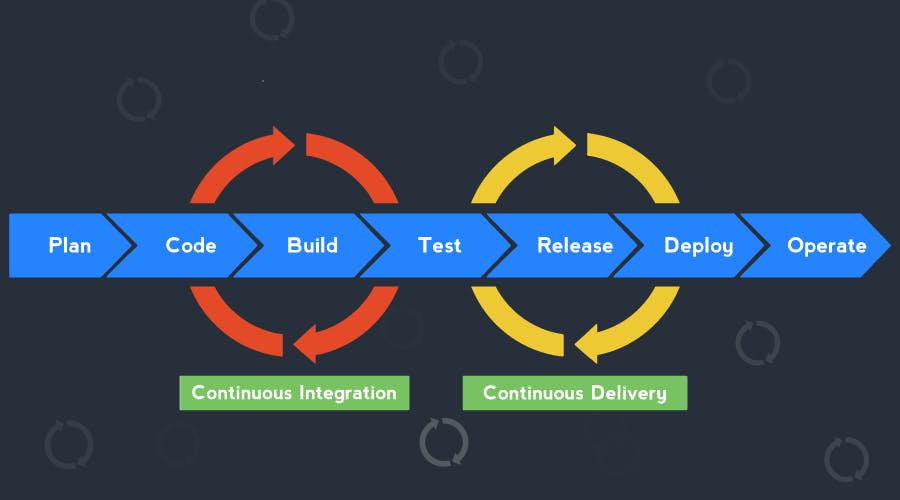The Ultimate Guide to DevOps: Revolutionizing the Development World
Step by step guide to DevOps
Table of contents
- Introduction
- Definition of DevOps
- Explanation of its Importance
- Brief History of DevOps
- The Key Components of DevOps
- The Benefits of Adopting DevOps
- The Role of Culture in DevOps
- Challenges in Implementing DevOps
- Best Practices for Successful DevOps Implementation
- Tools and Technologies Used in DevOps
- DevOps in Different Industries
- Case Studies
- Certification in DevOps
- Future of DevOps
- Conclusion
- FAQs
- What is DevOps?
- Why is DevOps important?
- What are the benefits of implementing DevOps?
- What are the key components of DevOps?
- What challenges are associated with DevOps implementation?
- What are some best practices for implementing DevOps?
- Which tools and technologies are used in DevOps?
- Why is certification important in DevOps?
- What are some emerging trends in DevOps?
- What is the future outlook for DevOps?
Introduction
DevOps is changing the way software development and operations teams work together to deliver better software at a faster pace. This guide explores what DevOps is, why it's important, its benefits, key components, challenges, and best practices for successful implementation.

Definition of DevOps
DevOps is a movement or cultural shift that emphasizes communication, collaboration, and integration between software development and IT operations teams to automate the software delivery process.

Explanation of its Importance
DevOps facilitates collaboration between developers and IT operations while automating the software delivery process. The main objective is to reduce the time to market while ensuring that the software is of high quality. It streamlines the entire software development lifecycle, making it more efficient and effective.
Brief History of DevOps
The term DevOps was coined in 2009 by Patrick Debois and Andrew Shafer, who organized the first DevOpsDays conference in Belgium. The conference aimed to bring together developers, IT professionals, and management to discuss ways to improve the software delivery process. Since then, DevOps has rapidly gained in popularity and now enjoys broad adoption among enterprises.
The Key Components of DevOps
To achieve the objectives of DevOps, there are several key components:
Collaboration Between Development and Operations Teams
Collaboration and communication between development and operations teams are critical. DevOps encourages teams to work together, share knowledge, and help each other to achieve the common goal of delivering better software.
Implementation of Automated Testing
Automated testing helps ensure that the software is of high quality, reducing the risk of introducing bugs in the code. It also helps increase the speed of the development process by automating repetitive tasks.
Continuous Integration and Continuous Delivery
Continuous Integration (CI) is the practice of regularly merging code changes from developers into a shared repository. Continuous Delivery (CD) is the process of automatically deploying the changes to the production environment. These practices help ensure that software is continuously tested, integrated, and deployed, reducing the time to market and ensuring the software's quality.

Infrastructure as Code
Infrastructure as Code (IaC) is the use of machine-readable files to describe infrastructure configurations. Developers can use IaC to define infrastructure, reducing manual processes and increasing the speed of infrastructure provisioning.

The Benefits of Adopting DevOps
Adopting DevOps provides a range of benefits, including:
Faster Time-to-Market
DevOps reduces the time it takes for software to reach end-users, resulting in faster time-to-market.
Improved Product Quality
DevOps practices increase the speed of software development while ensuring that the software is of high quality. Automated testing, continuous integration, and continuous delivery provide developers with instant feedback, enabling them to quickly detect and fix bugs.
Increased Collaboration and Communication
DevOps promotes collaboration and communication between teams, making it easier for them to work together and share knowledge.
Cost-Effectiveness
DevOps encourages teams to automate tasks that were previously done manually, reducing overall costs while improving the efficiency of the software development process.
The Role of Culture in DevOps
Culture is a critical aspect of DevOps, and it emphasizes the need for a collaborative, communicative, and nurturing culture within software development teams. The following are examples of the cultural elements that support the DevOps way of working:
Importance of a Collaborative and Communicative Culture
In DevOps, the emphasis is on collaboration and communication between teams and stakeholders. A culture of openness and collaboration helps reduce the friction between teams and promotes innovative thinking.
Implementing a Culture of Continuous Learning and Improvement
The DevOps culture emphasizes continuous improvement, and this requires a willingness to learn new things and continuously develop skills.
Empowering and Trusting Employees
DevOps teams must have the freedom to innovate and make decisions. Empowering employees and trusting them to do their jobs allows them to take ownership of their work.
Challenges in Implementing DevOps
Implementing DevOps is not without challenges. The following are some of the challenges associated with implementing DevOps:
Resistance to Change
There may be resistance from stakeholders who prefer traditional ways of working.
Lack of Expertise
DevOps requires technical skills and knowledge, and there may be a skills gap among team members that need to be resolved.
Integration Challenges
Integrating different tools and technologies can be complex and time-consuming.
Security Concerns
Security is critical in software development, and DevOps introduces new security concerns that need to be addressed.
Best Practices for Successful DevOps Implementation
To overcome the challenges associated with implementing DevOps and achieve sustainable success, the following are best practices:
Start Small and Iterate
Start with small projects and iterate as you go. This allows you to identify and resolve issues and build confidence in the DevOps approach.
Invest in the Right Tools
Identify and invest in tools that support automation, testing, continuous integration, and continuous delivery. The right tools can help reduce manual tasks, streamline processes, and improve efficiency.
Foster a Culture of Continuous Improvement
Creating a culture of continuous improvement helps teams to learn from failures, innovate, and try new approaches.
Measure and Track Progress
Ensure that you monitor the development process, measure its effectiveness, and track progress to make informed decisions and identify areas for improvement.
Encourage Cross-Functional Collaboration
DevOps is all about collaboration, so encourage it across functional teams by bringing together developers, IT operations, and other stakeholders.
Tools and Technologies Used in DevOps
To automate the software delivery process, several tools and technologies are used in DevOps. These include:
Configuration Management Tools
Tools such as Puppet, Chef, and Ansible automate the configuration of servers, databases, and applications.

Continuous Integration and Delivery Tools
Tools such as Jenkins, Github actions, GitLab CI/CD and Travis CI automate the testing, building, and deployment of applications.

Monitoring and Analytics Tools
Tools like Nagios, Zabbix, Prometheus, and Stackdriver help monitor and analyze application performance, infrastructure, and logs.
Containerization and Orchestration Tools
Tools like Docker, Kubernetes, and Mesos are used to isolate applications, simplify deployment, and enable containerized applications to run across different environments.

DevOps in Different Industries
DevOps is being adopted across a wide range of industries, and the benefits are becoming apparent to many organizations. Here are some examples of how DevOps is being used in different industries:
E-commerce
In e-commerce, DevOps can improve the speed at which new features and changes can be released, helping to stay ahead of competitors.
Healthcare
In healthcare, DevOps can support faster, more efficient delivery of clinical software systems and electronic health records, ultimately improving patient care.
Banking and Finance
In banking and finance, DevOps processes can help ensure secure and reliable applications that are compliant with regulatory requirements.
Manufacturing
In manufacturing, DevOps can help improve processes around manufacturing processes and systems, by automating and streamlining inventory management, logistics, and supply chain processes.
Case Studies
Many organizations have successfully adopted DevOps practices. Here are a few examples:
Netflix
Netflix provides an online streaming service for TV shows and movies. By adopting a DevOps approach, they can deliver new features and functionality to users at speed and scale.
Etsy
Etsy is an online marketplace that connects makers and buyers of handmade goods. Etsy uses DevOps practices such as continuous deployment, fail-fast culture, and blameless post-mortems to empower developers, maintain a faster development cycle, and improve the customer experience.
Amazon
Amazon processes billions of transactions every day, making DevOps a key factor in the company's success. In addition to being among the first companies to adopt cloud computing, Amazon has long been committed to DevOps.
Target
Target, a leading US retailer, has shifted its IT infrastructure to a cloud-based environment and adopted DevOps practices to reduce the time it takes to get products to market, improve stability, and enhance functionality.
Certification in DevOps
Certification in DevOps is becoming increasingly popular, and there are various certifications available, such as:
Popular DevOps Certifications
AWS Certified DevOps Engineer – Professional
Ansible Certified Professional
Docker Certified Associate
Importance of Certification
Certification helps validate an individual's DevOps knowledge and skills, making them more valuable in the market.
Advantages of Being Certified
People who are certified in DevOps are likely to command higher salaries, have increased job opportunities, and be viewed as experts in their field.
Future of DevOps
DevOps is still a relatively young practice, but the future is exceptionally promising, given the following emerging trends:
Emerging Trends in DevOps
DevOps for Multi-Cloud
DevSecOps
AI and Machine Learning in DevOps
Impact of AI and Machine Learning on DevOps
AI and machine learning is becoming increasingly important in DevOps. These technologies can be used to automate testing, optimize resource usage, and detect and resolve issues proactively.
Predicted Growth and Demand for DevOps Professionals
DevOps professionals will continue to be in high demand as more and more organizations recognize the benefits of DevOps and seek to adopt its practices.
Conclusion
In conclusion, DevOps is a powerful methodology that has revolutionized software development and operations. The benefits, key components, challenges, and best practices for its implementation have been discussed in detail. With the right mindset, tools, and processes, DevOps can help organizations deliver software faster and at a higher quality.
FAQs
What is DevOps?
DevOps is a cultural shift that emphasizes communication, collaboration, and integration between software development and IT operations teams to automate the software delivery process.
Why is DevOps important?
DevOps facilitates collaboration between developers and IT operations while automating the software delivery process. The main objective is to reduce the time to market while ensuring that the software is of high quality. It streamlines the entire software development lifecycle, making it more efficient and effective.
What are the benefits of implementing DevOps?
Adopting DevOps provides a range of benefits, including faster time-to-market, improved product quality, increased collaboration and communication, and cost-effectiveness.
What are the key components of DevOps?
The key components of DevOps include collaboration between development and operations teams, automated testing, continuous integration and delivery, and infrastructure as code.
What challenges are associated with DevOps implementation?
Some of the challenges associated with implementing DevOps include resistance to change, lack of expertise, integration challenges, and security concerns.
What are some best practices for implementing DevOps?
Best practices for DevOps implementation include starting small and iterating, investing in the right tools, fostering a culture of continuous improvement, measuring and tracking progress, and encouraging cross-functional collaboration.
Which tools and technologies are used in DevOps?
Tools and technologies used in DevOps include configuration management tools, continuous integration and delivery tools, monitoring and analytics tools, and containerization and orchestration tools.
Why is certification important in DevOps?
Certification helps validate an individual's DevOps knowledge and skills, making them more valuable in the market.
What are some emerging trends in DevOps?
Emerging trends in DevOps include DevOps for Multi-Cloud, DevSecOps, and the use of AI and machine learning.
What is the future outlook for DevOps?
DevOps is still a relatively young practice, but the future is promising, given the increasing demand for DevOps professionals and the emerging trends in the field.
